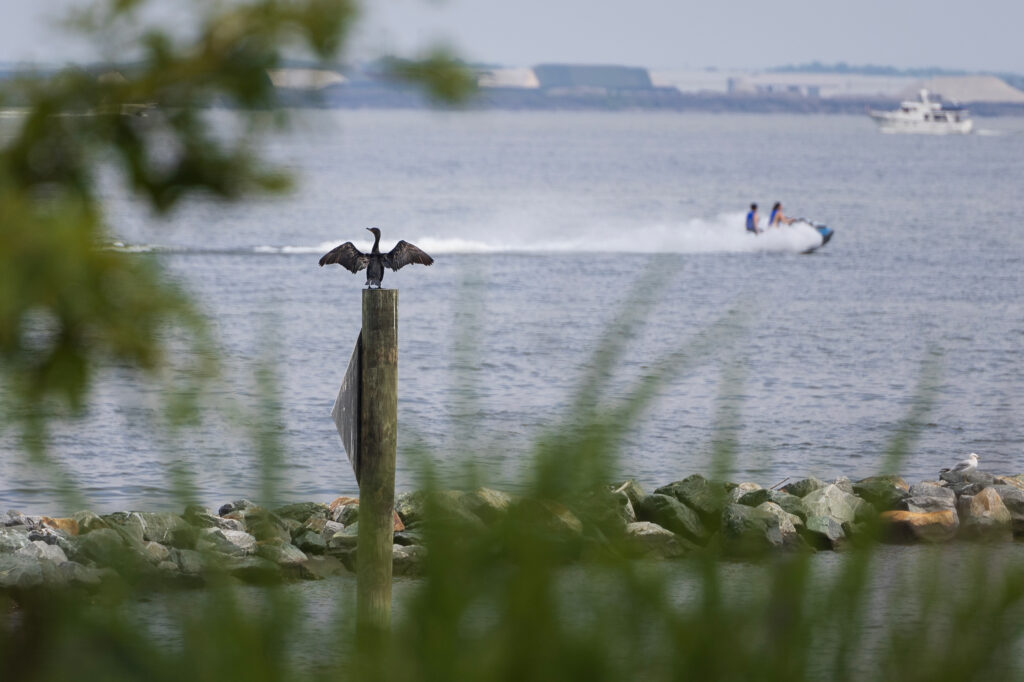
The management board of the Chesapeake Bay Program will meet this week to hammer out the next iteration of the agreement that has governed the restoration of the watershed for more than four decades. But this year, they face dual challenges of getting states to sign off on a robust, accountability-driven pact while anticipating a hands-off approach from an Environmental Protection Agency that is already pushing for less ambitious goals.
The draft agreement, released for public comment between July 1 and Sept. 1, has been criticized by scientists, advocates and citizen groups for weakening legal accountability under the Clean Water Act and diluting the enforcement of the Bay’s 2010 pollution limits, known as the Total Maximum Daily Load, or TMDL.
As Inside Climate News previously reported, the new framework cut the 2014 agreement’s 10 goals and 31 outcomes down to 4 goals and 21 outcomes. Pollution targets were left blank, deadlines were pushed back as far as 2040 and oversight timelines were replaced with undefined “X-year” review periods. Several restoration goals were scaled back without explanation.
The EPA, in its Aug. 27 comments, criticized the placeholders drafters included in the initial document and proposed eliminating some restoration targets, fending off more expansive and ambitious Bay clean up efforts. Observers are now watching and waiting to see if the states will step in and take on the leadership role needed to steer the next phase of the partnership.
For now, they appear divided. Maryland, as chair of the Chesapeake Bay Executive Council, is expected to push for stronger accountability, as it has done in the past. But without the EPA backing such efforts, its influence has limits. Virginia and the District of Columbia have both argued for keeping climate resiliency central to the agreement. Delaware and New York generally side with stronger, science-based targets.
Pennsylvania, and to a lesser extent West Virginia, remains the outlier, with decades of shortfalls in curbing agriculture runoff, frustrating other states. “If EPA is backing away, then it’s either Maryland and Virginia stepping up or another lost decade,” one official familiar with the internal talks told Inside Climate News.
It’s unclear how far Annapolis can push the EPA or other states into accepting more ambitious and expansive Bay restoration goals.
In emailed comments, A.J. Metcalf, a spokesperson for the Maryland Department of Natural Resources, said, “Maryland is actively working with other Chesapeake Bay watershed states and the federal government to strengthen the revised Chesapeake Bay Agreement based on public feedback.” He said the state has met its share of clean water targets and “would like other states to accelerate progress to meet their clean water goals as well.”
Pointing out that “only the EPA has the power to hold other states accountable” to pollution control targets, Metcalf said that “Maryland can not dictate to other signatories what must be in the agreement. Instead, the signatories must decide collectively what they believe is the best course of action.”
Work is ongoing to “develop cost-effective, ambitious yet achievable and scientifically-based goals that will improve the health of the Chesapeake Bay and its watershed during the next decade,” he said.
Despite a bipartisan agreement in the U.S. Senate that would keep the partnership going and funded, questions have arisen about the EPA’s commitment to the cleanup framework and comprehensive restoration targets. Under previous administrations, the EPA committed to cleaning up the Bay and nudged states to meet targets through funding and oversight.
But in the second Trump administration, longtime Bay observers say the EPA has narrowed its stance, stressing measurable outcomes over broader goals. That shift, they believe, has real consequences: By trimming or eliminating monitored outcomes for habitat, mussels and wetlands, the agency is signaling that only the most easily measured targets count, even if that means other ecological priorities are left out.
In its comments on the draft agreement, the EPA added to ongoing criticism of the placeholder values it contained. “The continued inclusion of placeholders, instead of specific values, prevents signatories from being able to assess the resources required to achieve the outcome, making it difficult for partners to determine if the target is realistic and achievable,” the comments read. “The continued inclusion of placeholders also makes it more difficult for partners to hold ourselves accountable and to clearly communicate with the public and key stakeholders.”
The agency recommended removing or deferring several draft outcomes and targets—including those on fish habitat, freshwater mussels, acid mine drainage and waterbirds—citing a lack of baselines, committed partners or funding. The EPA also suggested removing placeholders for wetlands, watershed health, tribal lands, agricultural lands and urban lands from the agreement, saying these made commitments difficult to calculate or measure progress. They “are not ready for inclusion in the Agreement at this time,” the agency wrote.
Anna Killius, executive director of the Chesapeake Bay Commission, previously told Inside Climate News that placeholders were purposely included in the draft. “Blanks or Xs were intentionally left for specific targets and update intervals where more information from our subject matter experts and the public would be particularly helpful in guiding us to a final number,” she said in August.
Later in its comments, the agency doubled down. “If these suggested revisions are not made, the EPA will stand aside during voting if multiple Management Board signatories support the inclusion of the targets listed above, as they are currently written, in the Agreement,” it warned. The agency stressed that its recommendations are provided “as a partner, not in our role as Chair of the Management Board,” stopping short of threatening enforcement withdrawal.
To those familiar with past agreements, who were already displeased with the 2025 draft, this marked a sharp departure from the EPA’s longtime role as the federal driver of Bay restoration and could risk weakening the framework meant to restore the estuary from decades of decline.
In a joint comment on the 2025 draft, Jon Mueller, former vice president for litigation at the Chesapeake Bay Foundation, and Bob Perciasepe, a former Maryland environment secretary and EPA deputy administrator, wrote, “Overall, we find the Draft lacking an accurate accounting of the status of Bay restoration, specifics on tasks to complete and when they will be completed, and most importantly leadership.”
They noted that after nearly 40 years of agreements and restoration efforts, the Bay’s condition remains largely stagnant. “The percentage of the tidal Bay in attainment for water quality standards is only three percent higher than in 1985–87,” they said. “Urban stormwater pollution is growing, not reducing, even though it is one of the two primary sources of pollution.”
In a separate comment, submitted on Aug. 11, four of the region’s leading estuarine scientists—Donald Boesch, Walter Boynton, Robert Diaz and Robert Howarth—warned that the draft undermines accountability. “In stark contrast with the three antecedent agreements, the draft revision includes no specific quantitative targets or timeline for achieving them,” they wrote.
They added the current pace of progress is so slow that “as the current level of attainment is about 30 percent, this implies a trajectory of as many as 350 years to reach full attainment.” Their comments urged Agreement signatories to set a firm deadline and stressed the climate consequences of delay. Without stronger pollution cuts, they warned, the Bay’s oxygen-depleted dead zones will persist and polluted waters will continue emitting methane and nitrous oxide, potent greenhouse gases that contribute to global warming.
Mueller and Perciasepe, in their submitted comments, pointed to another omission: the disappearance of environmental justice and climate resiliency goals that were included in the 2014 Agreement and its 2020 amendment. “Environmental justice should be a stated objective of the 2025 Bay Agreement,” they wrote. “It is abundantly clear that the current leadership at US EPA is on a different course than the Bay Partnership with respect to Environmental Justice and Climate Change.” On climate resiliency, they added: “The omission of this goal was done to appease a federal partner that wishes to ignore the problem while Bay residents suffer.”
The EPA, in an emailed response to questions, defended its insistence on measurable outcomes. “We’re working with our partners to ensure all outcomes and targets included in the Agreement will be measurable and attainable,” wrote EPA spokesperson Derek VanHorn. Explaining the agency’s assertion that it will “stand aside” in the final vote, VanHorn said: “To ‘stand aside’ means that an entity trusts the group and will not block a particular decision. This does not mean EPA is disregarding its responsibilities to the program.”
He defended the EPA’s suggestion to remove placeholders from the draft, saying that at a recent meeting of the Chesapeake Bay Program Management Board, “partners agreed that the final revised outcomes should not include placeholders” and that public comments were also not in favor of doing so.
“EPA will continue to meet its regulatory and enforcement responsibilities under the Clean Water Act,” VanHorn added.
Experts say the failure of past agreements often stemmed from missed deadlines and a lack of enforcement. The Total Maximum Daily Load, introduced in 2010, was supposed to set binding pollution limits on nitrogen, phosphorus and sediment for partner states to commit to. But the EPA’s reluctance to penalize lagging states—particularly Pennsylvania for missing agricultural runoff targets—has weakened the measure’s effectiveness.
The 1987 agreement set a 40 percent nutrient reduction target by 2000. The 2000 agreement expanded the scope, pledging broader Bay restoration by 2010. The 2014 agreement tied the cleanup to the pollution diet, or TMDL, setting a 2025 goal. None of those deadlines were met.
Climate change is compounding the Bay’s challenges, according to scientists, bringing heavier rainfall that sweeps more pollution into tributaries. Rising seas and warming waters are intensifying algal blooms and oxygen-depleted dead zones. As Boesch and his colleagues noted, these impacts will worsen without aggressive near-term action, and every year of delay deepens the scale of the cleanup needed later.
In his emailed comments, Boesch said accountability has long been lacking, particularly when it comes to the TMDL, “the only thing that is legally required.” He warned that “for the first time since the 1987 agreement, [the draft] will not include a timeframe in which it is to be accomplished … After nearly 40 years in this pursuit, this is effectively a capitulation that we will never achieve these pollutant reductions.”
Boesch agreed that states need to show more leadership but cautioned that a strong federal role remains critical, especially on water pollution, interstate coordination and providing financial and scientific resources. “However, the states can push forward on addressing climate change and environmental justice, forbidden issues during the Trump Administration, even if they are called something else in the new Bay agreement,” he said.
The management board will finalize the proposed revisions to the draft at its upcoming meeting, ahead of the December 2025 deadline for finalizing the new agreement.



